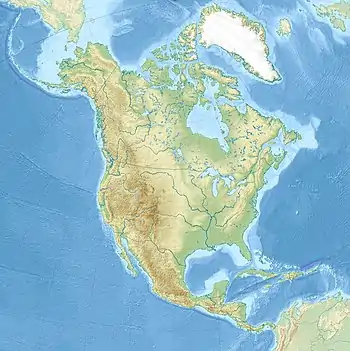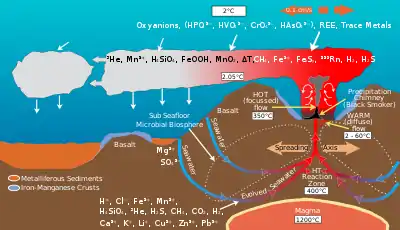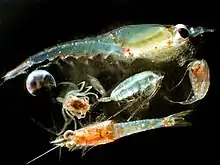Endeavour Hydrothermal Vents
The Endeavor Hydrothermal Vents are a group of hydrothermal vents in the northeastern Pacific Ocean, located 260 kilometres (160 mi) southwest of Vancouver Island, British Columbia, Canada.[2]
| Endeavour Hydrothermal Vents Marine Protected Area | |
|---|---|
 Part of a 360 °C black smoker chimney of the Endeavour Hydrothermal Vents | |
 | |
| Location | Juan de Fuca Ridge British Columbia, Canada |
| Coordinates | 47°57′N 129°06′W |
| Area | 97 km2 (37 sq mi)[1] |
| Designation | Marine Protected Area |
| Designated | March 2003 |
| Governing body | Fisheries and Oceans Canada |
This group of hydrothermal vents lies 2,250 metres (7,380 ft) below sea level in an area where the Pacific Ocean seabed is being pulled apart called the Endeavor Segment, which forms part of a larger spreading center called the Juan de Fuca Ridge.
Hydrothermal vents form in volcanically active areas, such as mid-ocean ridges where two plates are diverging, separating from each other, resulting in the formation of new crust.[3] At such sites, water penetrates through the hot crust, causing the pressure and temperature to change, resulting in precipitation of minerals, eventually creating hydrothermal chimneys. After the hydrothermal fluids temperature decreases and mixes with the seawater, the environment will reach ideal thermal and chemical conditions that support a unique biological community.[4]
Fluid circulation
Hydrothermal vents typically form on the tectonic plate boundaries and in association with hotspots. Seawater flows through the cracks of the volcanic bed which heats the water and cools the Earth. This allows the hydrothermal fluids to flow up and out of the crust and into the ocean. This heated water supplies energy and nutrients for chemoautotrophic organisms to thrive in this environment.[5] 800 individual chimneys have been recorded over a 15 kilometres (9.3 mi) section of the ridge.[6]

Heat source
Heat in the Endeavour Hydrothermal Vents are supplied by the cooling of the Earth's crust in areas of high seismic activity. The water is supplied by the ocean and seeps into the Earth's crust and rises back up out of the surface after it is heated. The hydrothermal fluids come from below the surface of the Earth and rise up above the surface.[6]
Fluid fluxes and chemistry
Energy flux caused by high temperature gradients in the Endeavour Hydrothermal Vents contributes to the production of chemical reactions that are necessary for life to exist, sparking the synthesis of organic compounds. These changes in temperature are caused by the cooling of the magma once it penetrates the surface of the Earth, making contact with the seawater.[4] These hydrothermal fluids can reach temperatures for up to 402 °C.[6]
Biology
Hydrothermal vents are located at mid-ocean ridges, where an abundance of life is present, providing high biodiversity of productivity. They provide habitats for many unique species of animals.[7] The Juan De Fuca Ridge is home to 60 unique species in the world. Specifically in the Endeavour Segment, there are 12 species that are unique to this area which do not exist anywhere else in the world including the sea spider (Sericosura Venticola).[8] A sulfide-hosted microbe from this site can live in environments up to 121 °C, which is the record for the upper limit for life.[6][9]
Marine protected area designation
Due to the rich biodiversity in the Endeavour Hydrothermal Vents, the Canada's Oceans Act declared this site as the first marine protected area in 2003.[10] The marine protected area management ensures that human activities help instead of hinder the environment including conserving and protecting the biodiversity of the space, while increasing research and public awareness of the environment as well.[11] All regulations can be found in the Endeavour Hydrothermal Vents Marine Protected Area Regulations.
Cabled observatory
Since 1987, Canada has been utilizing their cabled observatory called North Pacific Time-Series Underwater Experiment (NEPTUNE). NEPTUNE was founded by the Science Foundation's Ocean Observatories Initiative (OOI).[6] Some examples that NEPTUNE can measure are temperature, salinity, and methane content of the seafloor. These are measured with a collection of instruments that are powered with cables that are long enough to connect to land power, allowing real-time monitoring.
Scientific discoveries

The Endeavour Hydrothermal vents are home to several important scientific discoveries which include:
- 1982: discovery of the first vents in Juan de Fuca Ridge
- 1984: exploration of the first extensive seafloor ore deposits
- 1989: discovery of glowing vents, which are vents that emit thermal radiation due to high temperature fluids above 350 °C coming out of the vent.
- 1990: discovery of highest neutral water temperatures known to Earth
- 1991: first extensive usage of undersea robotic vehicles
- Discovery of the organism that holds the record for the upper temperature limit to life (121 °C)
- First evidence that hydrothermal plumes were zones of greatly enhanced zooplankton aggregation
- First measurements of biomass fluxes relating to hydrothermal plumes
To this day, the Endeavour Hydrothermal Vents still continues to be a site where scientists such as biologists, geologists, physicists, microbiologists, and oceanographers gravitate toward to find new discoveries.[12]
See also
- Volcanism in Canada
- List of volcanoes in Canada – Wikipedia list article
- Marine Protected Areas of Canada
References
- Government of Canada, Fisheries and Oceans Canada (2019-09-18). "Endeavour Hydrothermal Vents Marine Protected Area (MPA)". www.dfo-mpo.gc.ca. Retrieved 2020-09-10.
- Leary, David Kenneth (2007). International Law and the Genetic Resources of the Deep Sea. Martinus Nijhoff Publishers. ISBN 978-9004155008.
- Society, National Geographic (2013-03-21). "Deep Sea Hydrothermal Vents". National Geographic Society. Retrieved 2017-05-17.
- Colín-García1, María; Heredia, Alejandro; Cordero, Guadalupe; Camprubí1, Antoni; Negrón-Mendoza, Alicia; Ortega-Gutiérrez, Fernando; Beraldi, Hugo; Ramos-Bernal, Sergio. "Boletín de la Sociedad Geológica Mexicana". boletinsgm.igeolcu.unam.mx. Retrieved 2017-06-02.
- "Hydrothermal Vents" (PDF). School of Marine Science and Technology.
- "Endeavour Segment of the Juan de Fuca Ridge: One of the Most Remarkable Places on Earth | Oceanography". tos.org. Retrieved 2017-06-02.
- Administration, US Department of Commerce, National Oceanic and Atmospheric. "What is a hydrothermal vent?". oceanservice.noaa.gov. Retrieved 2017-05-17.
- "Endeavour Hot Vents". ibis.geog.ubc.ca. Retrieved 2017-06-02.
- Kashefi, Kazem; Lovley, Derek R. (2003-08-15). "Extending the Upper Temperature Limit for Life". Science. 301 (5635): 934. doi:10.1126/science.1086823. ISSN 0036-8075. PMID 12920290. S2CID 21189391.
- "Endeavour Hydrothermal Vents MPA". Fisheries and Oceans Canada. February 3, 2017.
- "Endeavour Hydrothermal Vents Marine Protected Area Regulations" (PDF). Minister of Justice. April 25, 2017. Retrieved May 8, 2017.
- Tunnicliffe, Verena and Richard Thomson. 1999. The Endeavour Hot Vents Area: A Pilot Marine Protected Area in Canada's Pacific Ocean. Fisheries and Oceans Canada, Sidney, BC.